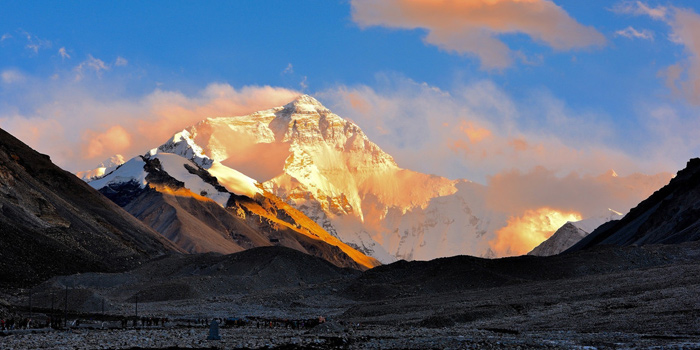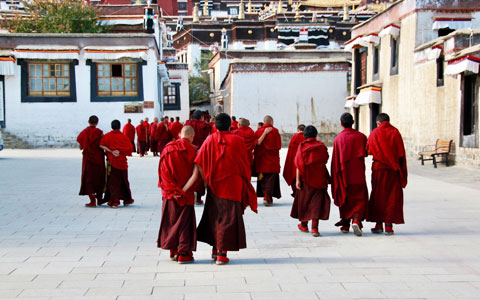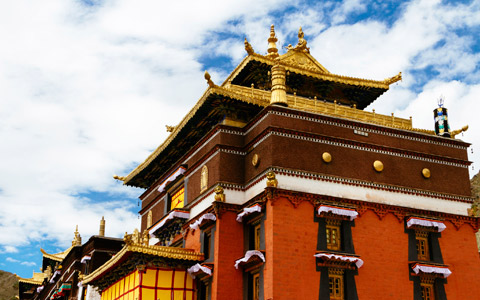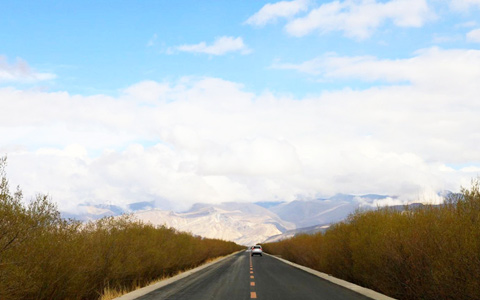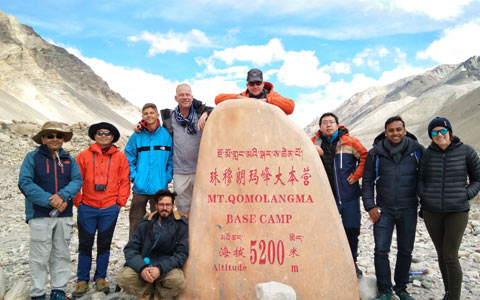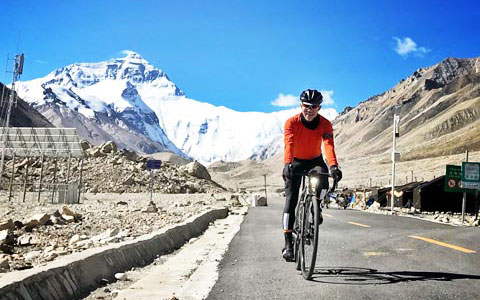Shigatse Railway Station: Transportation Hub for Lhasa Shigatse Everest Travel
Nestled in the heart of Shigatse, Tibet's second-largest city, the Shigatse Railway Station isn't just a transportation hub; it's the starting point for unforgettable Himalayan adventures. In this article, we'll explore the location of Shigatse Railway Station, the train schedules, the tourist attractions around it, and more travel planning tips.
 Where is Shigatse Railway Station?
Where is Shigatse Railway Station?
 Shigatse Train Schedule and Timetable
Shigatse Train Schedule and Timetable
 Top Attractions around Shigatse Railway Station
Top Attractions around Shigatse Railway Station
Where is Shigatse Railway Station?
Shigatse Railway Station, also known as Rikaze Railway Station in Chinese, is the terminal station of the Lhasa-Shigatse Railway. It is located in Zhandui Village of Jiacuoxiong Township, about 5 kilometers away from the downtown of Shigatse and 248 kilometers away from Lhasa Railway Station. The station is a two-story building and is able to hold 300 people at the same time. In the square, you can see a rotational huge prayer wheel which makes Shigatse Railway Station an attraction in Shigatse. The station began to operate on August 16th, 2014. It offers a great convenience for locals and tourists to travel between Shigatse and Lhasa. The travel time between Lhasa and Shigatse on this line is roughly three hours.
 Shigatse Railway Station is the only train station in Shigatse region.
Shigatse Railway Station is the only train station in Shigatse region.
Shigatse Railway Station is about 9 kilometers away from the prominent Tashilhunpo Monastery. It takes about 20 minutes to get to Tashilunpo from Shigatse Railway Station by car. By the way, if you get to the railway station, you can take the bus No.4, No.7 and No.8 to downtown Shigatse. The price is only 2 CNY per person. For international tourists, if you want to take a bus in Shigatse, you need a travel guide to accompany you. Of course, taxis are also available here, but will cost you more. Moreover, we can offer our free shuttle bus service for you. Once you arrive at the Shigatse Railway Station, our tour guide will wait for you here.
Shigatse Train Schedule and Timetable
Xining Shigatse Train Schedule (No.Z6811 & No.Z6812)
Nowadays, there is only one train from Xining to Shigatse every day, Train No.Z6811 from Xining Railway Station, and the return train No.Z6812 from Shigatse to Xining. The train will cost you nearly 24 to 25 hours. Here is the detailed timetable of Xining Shigatse Train.
Timetable of Xining to Shigatse Train - No.Z6811
| Station | Altitude | Arrival | Departure | Stop Time | Days | Distance |
| Xining | 2,200 m | -- | 20:30 | -- | Day 1 | -- |
| Delingha | 2,980 m | 00:32 | 00:38 | 6 min | Day 2 | 521 km |
| Golmud | 2,780 m | 03:28 | 03:53 | 25 min | Day 2 | 830 km |
| Amdo | 4,800 m | 12:01 | 12:05 | 4 min | Day 2 | 1,524 km |
| Nagchu | 4,500 m | 13:39 | 13:45 | 6 min | Day 2 | 1,650 km |
| Damxung | 4,200 m | 15:39 | 15:47 | 8 min | Day 2 | 1,800 km |
| Lhasa | 3,650 m | 17:45 | 18:10 | 25 min | Day 2 | 1,972 km |
| Quxu | 3,650 m | 18:47 | 18:49 | 2 min | Day 2 | 2,028 km |
| Nyemo | 3,701 m | 19:21 | 19:23 | 2 min | Day 2 | 2,075 km |
| Rinbung | 3,950 m | 19:54 | 19:56 | 2 min | Day 2 | 2,123 km |
| Shigatse | 3,836 m | 20:58 | -- | -- | Day 2 | 2,220 km |
Timetable of Shigatse to Xining Train - No.Z6812
| Station | Altitutde | Arrival | Departure | Stop Time | Days | Distance |
| Shigatse | 3,836 m | -- | 14:40 | 2 min | Day 1 | -- |
| Rinbung | 3,950 m | 15:43 | 15:45 | 2 min | Day 1 | 97 km |
| Nyemo | 3,701 m | 16:15 | 16:17 | 2 min | Day 1 | 145 km |
| Quxu | 3,650 m | 16:46 | 16:48 | 2 min | Day 1 | 192 km |
| Lhasa | 3,650 m | 17:31 | 18:00 | 29 min | Day 1 | 248 km |
| Damxung | 4,200 m | 19:46 | 19:50 | 4 min | Day 1 | 420 km |
| Nagchu | 4,500 m | 21:28 | 21:34 | 6 min | Day 1 | 570 km |
| Amdo | 4,800 m | 22:56 | 23:00 | 4 min | Day 1 | 696 km |
| Golmud | 2,780 m | 07:10 | 07:35 | 25 min | Day 2 | 1,390 km |
| Delingha | 2,980 m | 10:02 | 10:08 | 6 min | Day 2 | 1,699 km |
| Xining | 2,200 m | 14:25 | -- | -- | Day 2 | 2,220 km |
Lhasa Shigatse Train Schedule (C885,C923,C883)
As an extension of Qinghai-Tibet Railway, Lhasa-Shigatse Railway with a duration of 248 kilometers, currently, has operated two daily trains from Lhasa Railway Station to Shigatse Railway Station within 3 hours’ duration. Train C885,C923 and C883 depart from Lhasa to Shigatse every day. Here is the latest timetable of Lhasa Shigatse train. Since some changes often occur, please contact us for the final confirmation.
Timetable of Lhasa to Shigatse Train - C885
| Station | Altitude | Arrival | Departure | Stop Time | Days | Distance |
| Lhasa | 3,650 m | -- | 8:20 | -- | Day 1 | -- |
| Shigatse | 3,836 m | 10:42 | -- | -- | Day 1 | 248 km |
Timetable of Lhasa to Shigatse Train - C923
| Station | Altitude | Arrival | Departure | Stop Time | Days | Distance |
| Lhasa | 3,650 m | -- | 14:45 | -- | Day 1 | -- |
| Shigatse | 3,836 m | 17:25 | -- | -- | Day 1 | 248 km |
Timetable of Shigatse to Lhasa Train - C883
| Station | Altitude | Arrival | Departure | Stop Time | Days | Distance |
| Shigatse | 3,836 m | -- | 16:15 | -- | Day 1 | -- |
| Lhasa | 3,650 m | 18:39 | -- | -- | Day 1 | 248 km |
Top Attractions around Shigatse Railway Station
Tashilhunpo Monastery
Tashilhunpo Monastery, as the traditional seat of the Panchen Lama (the second most important Lama in Tibetan Buddhism), is located at the foot of Drolmari (Tara's Mountain), Shigatse with an altitude of 4,000 meters. It is a part of the Four Greatest Monasteries of Tibetan Gelugpa Sects together with Sera, Ganden, and Drepung Monastery in Tibet. It was founded by the first Dalai Lama, Gedun Drub in 1447. Tashilhunpo is the largest monastery in Shigatse and covers an area of about 150,000 square meters.
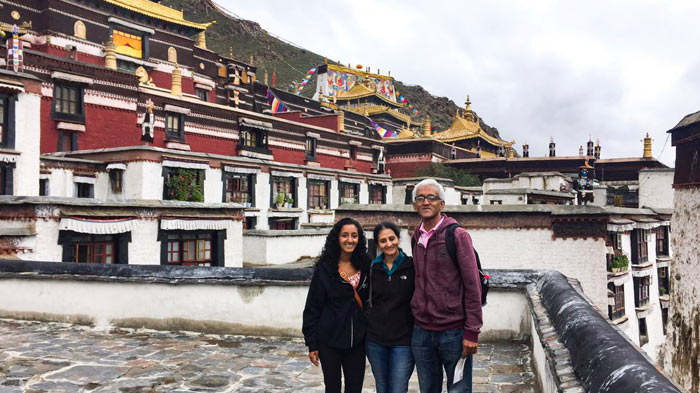 Our clients have attended the hilarious Buddha unfolding ceremony in Tashilhunpo Thangka Festival.
Our clients have attended the hilarious Buddha unfolding ceremony in Tashilhunpo Thangka Festival.
The sacred monastery is comprised of 57 halls and 3600 rooms. Among them, the Coqen Hall can hold 2000 monks chanting at the same time. It once had more than 4,700 monks. Currently, there are about 800. However, Tashilhunpo Monastery remains popular among locals. Like other eminent Tibetan monasteries, Tashilhunpo Monastery stores many treasures, including the giant Future Buddha Statue, precious Buddha Stupas, and countless murals. In addition, the annual Tashilhunpo Thangka Festival to shows three embroidered Buddhas is another attraction here.
Insider tips: The distance between Tashilhunpo Monastery and Shigatse Railway Station is around 9 kilometers. If you intend to get there from Shigatse Railway Station, you can walk there, or you can take a tricycle with about 10 CNY. Also, you can take a taxi to Tashilhunpo. The taxi will take you about 20 minutes and cost you 15 - 20 CNY.
Shigatse Dzong
Shigatse Dzong, also known as Samdruptse Dzong, is situated in Shigatse. Dzong means both a fortress and a county government in the Tibetan language. It was once the site of ancient Shigatse County administrations. The imposing Shigatse Dzong was built by Karma Phuntsok Namgyal in the 17th century as a smaller prototype of the Potala Palace in Lhasa. Later, it is thought that its design was used as the basis for the later construction of the Potala.
 Shigatse Dzong, an impressive hilltop fort, bears a close resemblance to the Potala.
Shigatse Dzong, an impressive hilltop fort, bears a close resemblance to the Potala.
Now, Shigatse Dzong is a well-preserved Dzong in Tibet. It contains a praying hall, a Buddhist hall, a county government office, a court, a prison, and a warehouse. Unfortunately, it has not been accessible to the public. But it has been one of the best scenic spots and landmarks of Shigatse. If you want to have the best view of Shigatse Dzong, you are highly recommended to walk the Tashilhunpo Kora.
Gongjue Linka
Gongjue Linka, also Dongfeng Linka, is an important tourist attraction and a perfect place for people to relax and vacation. Gongjue Linka is located on the bank of the Nianchu River in the northeast of Shigatse City. It is a place where Successive Panchen in the past to spend summer and conduct religious activities. It was built in the fifth year of the Qing Dynasty by the Seventh Panchen Lama following the example of Norbulingka.
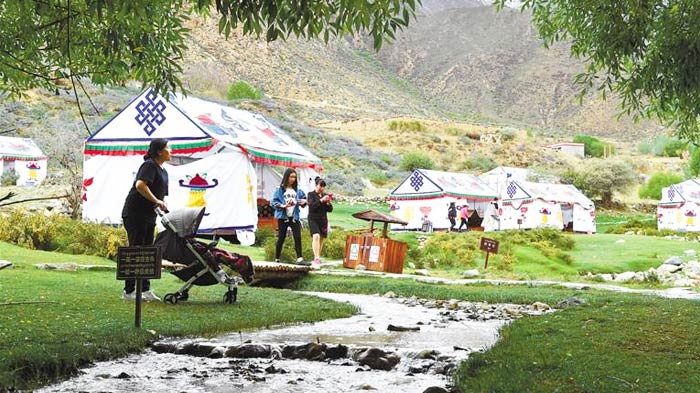 Gongjue Linka is a beautiful place where local people would like to spend their time having a picnic here.
Gongjue Linka is a beautiful place where local people would like to spend their time having a picnic here.
The Panchen Lama&rsquo's Summer Palace was built in Gongjue Linka, originally known as Deji Jingtang. Later, Emperor Daoguang used Tibetan, Han, Mongolian, and Manchu to write the Golden Plaque of the "Gongjue Linka Palace". And then, it was renamed as Gongjue Linka Palace. The main building of Gongjue Linka Palace is the Panchen Master's living room, office, five halls, and 100 Buddha statues.
In 1954, Gongjue Linka Palace was destroyed by the flood. However, after reconstruction, the architectural style of the new palace is a combination of tradition and modernity. And it has become a good place for locals to have fun. The palace is full of lush trees, colorful flowers, and gurgling water. An artificial river is carved to make it possible for tourists to go boating. There are also countless winding paths that can lead you to every corner of the palace.
In Shigatse, locals will hold grand gardening activities here to celebrate some important festivals such as Linka Festival. During the month of June, local people will get together to have a Linka (Tibetan picnic) here. If you travel to Shigatse, just try to have a Linka in Gongjue Linka to experience the local Tibetan lifestyle.
Nianchu River
Nianchu River, the largest and most important tributary of the Yarlung Tsangpo River, is located in Shigatse. Nianchu means "tasting the water" in the Tibetan language. The river has a total length of 217 kilometers and a drainage area of 11,130 square kilometers. Nianchu River Valley has been a developed agricultural area in Tibet since ancient times. And the valley enjoys a high reputation as the “ granary of Tibet; for its fertile land and abundant products.
 Having a visit to the beautiful Nianchu River Valley would be an excellent Shigatse travel experience.
Having a visit to the beautiful Nianchu River Valley would be an excellent Shigatse travel experience.
There is a legend about the Nianchu River. It is said that in order to help local people to have a taste of the nectar. Guru Rinpoche placed a treasure bottle with nectar at Ningjingang Sangxue Mountain. Since then, the nectar has flowed from the mountain without a break. The continuous nectar has gathered and become the Nianchu River. For travelers, with such a wide range of things to see in Shigatse, the little things like the awesome Nianchu River cannot be overlooked, so just to enjoy it.
How to Plan a 2-day Shigatse Train Tour from Lhasa?
Option A: Tashilhunpo Monastery, Sakya Monastery
You are able to take the train from Lhasa in the morning and arrive at Shigatse Station before noon. If you are in a hurry to visit Shigatse, you can have a simple lunch on the train. If not, there are some restaurants in Shigatse, and you can have lunch. After lunch, you will visit the Tashilhunpo Monastery which is the traditional seat of Panchen Lama. Of course, you can walk the Tashilhunpo Kora to experience the pilgrims’ minds or you can climb the slope behind the monastery to overlook the whole city of Shigatse. The next morning, you will drive to Sakya Monastery. After finishing visiting, you will return to Shigatse City on the same day, and take the train to Lhasa from Shigatse in the evening to end the two-day and one-night trip.
Option B: Everest Base Camp, Rongbuk Monastery
For this option, you will also take the train from Lhasa in the morning and arrive at Shigatse Station before noon. After lunch, you will start your Everest Base Camp trip. After several hours of driving, you can arrive at Everest Base Camp in the evening. Stay overnight in Base Camp Tent Houses. Visiting the Everest Base Camp and the world’s highest Rongbuk Monastery the next morning. Then, you can return to Shigatse by car. On the way, if time allows, you can have a detour to Sakya Monastery. If you go back to Shigatse early, you may spare some time to visit Tashilhunpo Monastery. And then, taking the train from Shigatse to Lhasa to end this trip.
Conclusion
In brief, Shigatse Railway Station is the only train station in Shigatse. It is situated in Zhandui Village of Jiacuoxiong Township. Since it was put into use, it offers travelers a great convenience to explore the holy Tashilhunpo Monastery, little Potala Palace - Shigatse Dzong, beautiful Gongjue Linka, winding Nianchu River, etc. Currently, travelers are able to take the train from Xining and Lhasa to Shigatse.
If you are planning a travel from Xining to Shigatse, you can take train No.Z6811 from Xining Railway Station. And return train No.Z6812 from Shigatse to Xining also available every day.
If you start your Tibet tour from Lhasa, you are able to visit Shigatse by train. The train C885, C923 and C883 will depart from Lhasa to Shigatse every day. After you have visited Shigatse, the return train C886, C924 or C884 will bring you back to Lhasa.
If you intend to a two-day Lhasa Shigatse train tour, there are two options. You can take the train from Lhasa in the morning and arrive before noon. After arriving, you can spend two days visiting the ancient Tashilhunpo Monastery and Sakya Monastery, or enjoying the amazing view of Mt. Everest from Rongbuk Monastery, and Everest Base Camp. The next evening, the train from Shigatse to Lhasa will bring you back.
More importantly, the Shigatse train schedule mentioned above are just for reference. If you have any questions about Shigatse travel, please feel free to leave your comments or contact us for more details.

The Lhasa-born prodigy used to study business overseas, and got his Bachelor of Business in Nepal and India before moving back to his homeland. With pure passion for life and unlimited love for Tibet, Kunga started his guide career as early as 1997.
Responsible, considerate, and humorous, he devoted his entire life to guiding and serving international tourists traveling in Tibet. As a legendary Tibetan travel guru with 20-year pro guide experience. Currently, he is working in Tibet Vista as the Tour Operating Director. Whenever our clients run into trouble, he is your first call and will offer prompt support.
Most Popular Tibet Tour Packages
-

Lhasa - Gyantse - Shigatse - Everest Base Camp - Shigatse - Lhasa
USD939
View Details -

Lhasa - Gyantse - Shigatse - E.B.C - Saga - Kailash Trek - Darchen - Lake Manasarovar - Saga - Gyirong - Tingri - Lhasa
USD2059
View Details -

10 Days Lhasa to Everest Base Camp and Namtso Lake Small Group Tour
Lhasa - Gyantse - Shigatse - EBC - Shigatse - Lhasa - Namtso Lake - Damxung - Lhasa
USD1289
View Details -

8 Days Driving Across Himalaya Overland Adventure from Kathmandu to Lhasa
Kathmandu - Gyirong - Everest Base Camp - Tingri - Shigatse - Gyantse - Lhasa
USD1069
View Details -

4 Days Lhasa Impression Small Group Tour: Explore the Heart of Tibet and Mingle with the Locals
Lhasa
USD509
View Details -

Lhasa - Gyantse - Shigatse - Everest Base Camp - Gyirong - Kathmandu
USD979
View Details -

Lhasa - Gyantse - Shigatse- Lhasa
USD799
View Details -

13 Day Lhasa, Mt. Everest, Mt. Kailash, Lake Manasarovar and Kathmandu Adventure Tour
Lhasa - Gyantse - Shigatse - EBC - Saga - Darchen - Kailash Trek - Darchen - Saga - Gyirong - Kathmandu
USD2059
View Details


.jpg)



